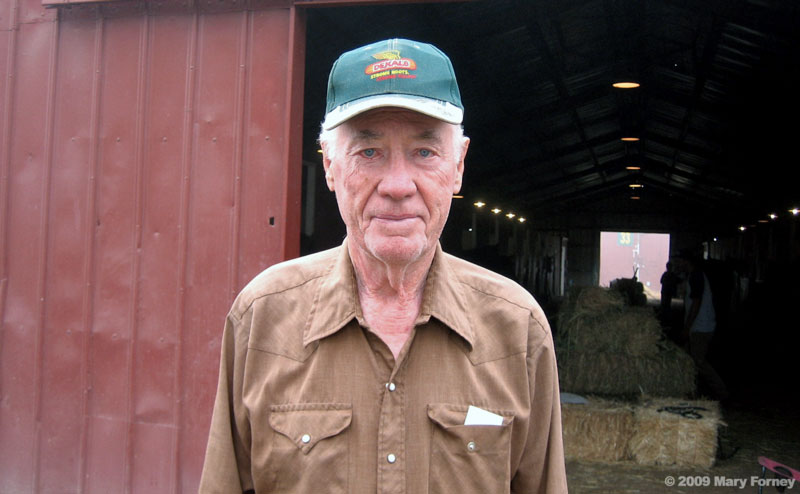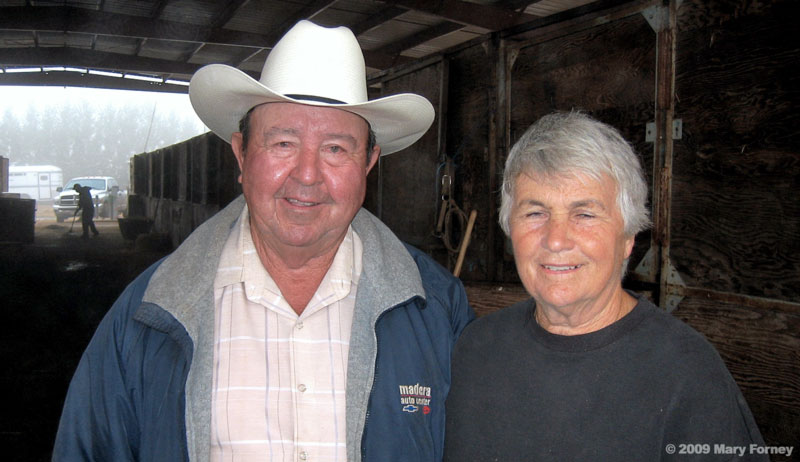A guest post by Walt Frazier
Unbelievable is the only adjective that can describe the California Fairs. Moving onto the backside at Stockton, Pleasanton, Vallejo, Santa Rosa, Ferndale, Sacramento, Pomona or Fresno is like stepping back in time to the way racing was from the early 1920’s to the 1950’s. The atmosphere is at once cordial, friendly, and bustling -- exactly why racing was the most widely viewed spectator sport in America.
The spring of 2009 was the first time I chose to run a string of horses at the fairs. I was welcomed by the racing officials; and the racing secretary at Stockton personally called me to ask if there was anything he could do to help me. I was shocked! Often at the major tracks, trainers and owners are treated as if the tracks are doing them a favor just allowing them to participate. At the fairs they realize that each and every owner and trainer has invested time, money and the love of racing just to be there.
Each race meet has been the same. People congregate in the RV section of the track to barbeque and tell tales of races and horses of long ago. Their minds are filled with memories of times past, when racing was king and dreams could, and sometimes did, come true. Racing horses is after all, the pursuit of dreams.
As a boy, I read Walter Farley’s Black Stallion and thrilled to the movies featuring Mickey Rooney, Elizabeth Taylor and countless others in National Velvet, Seabiscut and other stories of the American racing scene. I devoured the Quarter Horse Journal just to read “Quarter Chatter” and awaited the next issue of the Quarter Racing Journal to read about Jet Deck, Go Man Go, Tonto Bars Hank, Vandy’s Flash and other greats of Quarter Horse racing and at the same time read about the great Kelso, Gun Bow, Primonetta, Bold Ruler and the greats of the Thoroughbred track. I lived for racing and could not wait to be old enough to participate. But racing changed and not for the better.
But coming to the fairs has rekindled the love of old, and in a sense I have moved forward and back to the past. The fairs are part of Americana that may soon disappear. I am fortunate to have become acquainted with two grand old men of racing who exemplify what racing means -- Elmer January, an 84-year-old trainer who has forgotten more about racing than most newcomers will ever know, and Clarence Gordon Courtwright, a 77-year-old trainer who still, believe it or not, gallops his own horses.
Everyone calls him Clarence, but I knew him when I was a young boy of 16 as Gordon Courtwright. I rode races against this septuagenarian when he was a middle aged man in his thirties. He once gave a young jockey some sage advice after a horse I rode against him almost knocked him down leaving the starting gates: “Pick his head up jock, or next time you’ll go to school.” I knew what that meant, so I did.
Clarence and Elmer are up well before dawn feeding and caring for their horses without help. Elmer January is amazing. He has 11 horses and daily feeds them, cleans their stalls, saddles them, bathes them and then after all is done, repeats the cycle the next day. Clarence has only five but, remember, he also gallops and works his own horses. These are two truly amazing men, and it is an honor to be around them, listen to their stories, and heed their advice on any number of topics. They know how racing should be and remember when trainers and owners actually talked to each other, helped each other and worked together.
Another fixture on the fair circuit is Dick Whalen. Also a septuagenarian, Dick has had as varied a life as one can imagine. Along with his wife, Betty, Dick has raced as a Nascar and Indy driver, ran a successful speed shop for hot rod enthusiasts, and trained and raced both Thoroughbred and Quarter horses all over California. His love, though, is the fairs. Both he and Betty are licensed trainers, and each morning finds them taking care of the three or four horses in their stable.
Dick is a wealth of information, and the stories he tells of his friends sound like a who’s who of sports history. He is friends with Kenny Stabler, the great quarterback of the Oakland Raiders; A.J. Foyt, who is to auto racing what Muhammed Ali was to boxing, and a litany of other sports greats that he knows and competed against. To listen to him as he regales one with stories of both the auto and horse tracks is a trip down memory lane and could easily become a book worthy of the New York Times best seller list.
Whether talking to Elmer, Clarence or Dick, it is evident that they love what they are doing and each, in his own way, is an example of how people care about and love racing horses. To talk to any one of them is a history lesson, and one that should be told so that others can discover why horse racing was once the most popular sport in America. Time does not always change things for the better.
Elmer January has been a fixture on the Southern California racing circuit since the late 1940’s. He has been stabled at Los Alamitos longer than any trainer in the history of the track, and it is safe to say that there is no one who doesn’t like and admire him. Tall and rail thin, he starts each day with oatmeal and a banana, and begins his work routine long before the sun makes its appearance in the eastern sky. In an era when most trainers are content to sit on their pony horses or ride around on their golf carts surveying their horses as they train, having their grooms saddle, bathe and cool them out, Elmer walks to the track after saddling and getting them ready, and when they are finished, bathes and cools them out.
A total hands-on horseman, from the beginning of each training day Elmer is immersed in the care, feeding and exercise of his stable. Asking Elmer which was the best horse he raced brings a smile. He says, “I can remember the horse, but I can’t remember the name.” That is unless he is talking about Tom Lydon, a horse who won many races for Elmer, including the first Evangeline Downs Quarter Horse Derby in 1966, and became a Superior Race Horse. Elmer also helped Tomey Wieberg when the great Tonto Bars Hank was World Champion Running Horse in the early 1960’s.
He speaks fondly of Callie Can, Primo Hi, and Classic Tol, and laughs when he recalls Callie Can outrunning Fishers Favorite -- who went on to be one of the great producing broodmares of Quarter Horse history. His list of accomplishments on the track dates back to the 1950’s. His first win came at Bay Meadows. Elmer has just begun his sixth decade at Los Alamitos and is always thinking about the next good horse he will have.
Elmer, Clarence and Dick are three great examples of why one should spend some time on the fairs. Racing Thoroughbreds at the fairs keeps these three men young and continually planning for the next racing season.
 Walt Frazier taught high school world history for 22 years at Carlsbad High School in Carlsbad, Calif., and was named in Who's Who of American Teachers ten years. He has worked as a jockey from 1961 to 1983 and as a trainer from 1975 to the present. From 1984 to 1986, he worked for trainer D. Wayne Lukas in Southern California. Frazier is a Vietnam veteran (1966-1970).
Walt Frazier taught high school world history for 22 years at Carlsbad High School in Carlsbad, Calif., and was named in Who's Who of American Teachers ten years. He has worked as a jockey from 1961 to 1983 and as a trainer from 1975 to the present. From 1984 to 1986, he worked for trainer D. Wayne Lukas in Southern California. Frazier is a Vietnam veteran (1966-1970).
















1 comment:
lovely post and photographs. if you sepia-toned the pics, i'd have no idea what decade they were shot in. very well done!
Post a Comment